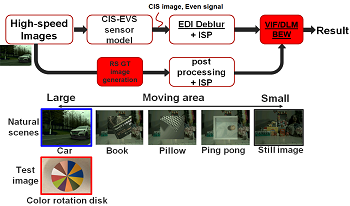
Event-based Vision Sensor (EVS) generates pixel-level and low-latency event data that is useful for reconstructing temporal components of images for deblurring. In this new application development, we need to know how EVS hardware parameters affect the natural motion scene image quality (IQ) to determine hardware specifications before starting design. To realize this approach, it is beneficial to build an End-to-End IQ simulation that runs from hardware simulations to natural motion scene IQ evaluation. Previously, we developed a Hybrid-EVS-CIS simulator to generate synthesized color rotation disk images and their event data fed into an image deblur block. Then image blurriness was evaluated by using the Blurred Edge Width metric (BEW). This paper proposes the extended IQ evaluation, which is an End-to-End IQ simulation for natural motion scenes. A simultaneous evaluation of blurriness and noise on images was verified by using Visual Information Fidelity and Detail Loss Metric. We also build a method to assess pixel-speed using BEW. Those IQ evaluation methods were the last pieces to realize End-to-End IQ simulation.

We report measurement methods and metrics for the evaluation of dynamic vision sensor (DVS) pixels. In particular, we developed automated test environments and test metrics which can quantify the sensitivity, latency and background noise of DVS pixels. For sensitivity measurements, response probabilities of pixels were analyzed at various conditions, such as base light intensity and region of interests of a sensor. Pixel latency was measured by varying the duty of light pulse, and noise level were also characterized at different light intensities. We expect the developed methods and metrics can help to clarify the performance of DVS pixels at the user point of view.